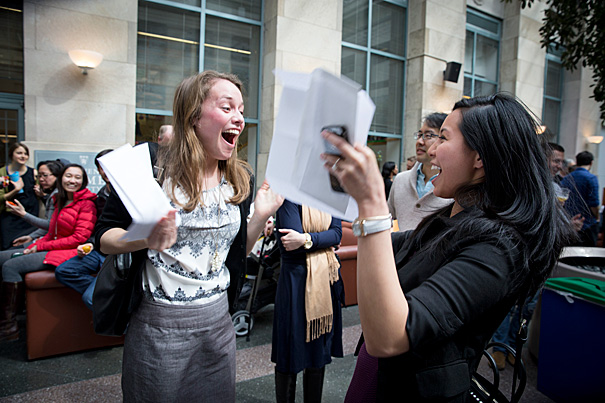
Harvard Medical School students Katherine Schiavoni (left) and Johanna Sheufind are ecstatic when they learn they are both headed to Massachusetts General Hospital.
Rose Lincoln/Harvard Staff Photographer
Matching dreams
Harvard Medical students learn their futures on first day of spring
The first day of spring is a time for beginnings. On the Harvard Medical School (HMS) campus, a few daffodils emerge from the ground as snow recedes and the first returning blackbirds chirp their songs. Another new season began Friday inside the Tosteson Medical Education Center. With the ringing of a bell, members of the Class of 2015 tore open the envelopes that revealed where they will spend the next three to seven years of their training in residency programs.
The annual ceremony, echoed at medical schools across the country, is part of the special event that is Match Day, when prospective residents learn what their futures hold.
Before the bell rang, Holmes Society student Brian Boyle said he was excited to learn what the next phase of his career had in store for him. Boyle was looking for a match in psychiatry. “I had no idea where I’d be now four years ago, and I’m excited to see where I’ll be for the next four years,” Boyle said, before learning he had matched to Massachusetts General Hospital.
“I’m looking forward to spending the rest of my career helping people with what I think is the worst kind of human suffering,” he said.
Sharing the experience
Matching students, along with their relatives and friends, assembled in the Tosteson atrium to celebrate with hugs and high fives, selfies and family photos. Some students were looking for old friends who would be colleagues at their new hospitals. Others contemplated moves across the country, and all were beginning to imagine how their blossoming careers might grow.
Grace Eckhoff, a Castle Society student currently researching cholera in Bangladesh, joined Match Day via Skype, with her virtual presence passed around the atrium on a laptop. Michael Kuntz of the Holmes Society carried his 6-month-old baby, Reagan, her yellow hair band matching his smart bow tie.
Christina Grassi, a member of the Cannon Society who matched in ophthalmology at New York-Presbyterian/Weill Cornell Medical Center, noted her appreciation for the strong sense of community at HMS that has bonded students and faculty, forming another kind of family.
“We don’t walk this road alone,” Grassi said. “Our dreams are shared dreams, which makes the experience even better.”
Samsiya Ona, a Peabody Society member originally from Togo, matched in Boston for a joint program in obstetrics and gynecology at Brigham and Women’s Hospital and Massachusetts General.
She hopes to become an expert in women’s health, focusing on maternal-fetal medicine. Ona plans to split time between Boston and Togo in the future. “I have two homes now,” she said. “I can’t really deny it.”
A day unmatched
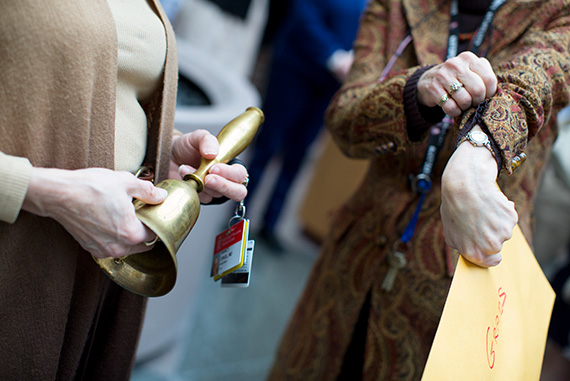
Students receive envelopes with their assigned residencies at noon on Match Day at Harvard Medical School. Photo by Rose Lincoln/Harvard Staff Photographer
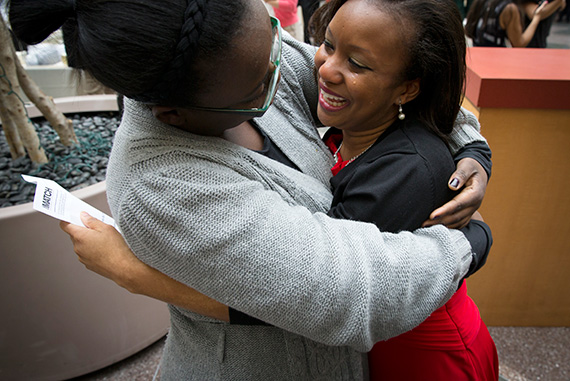
Nicole Jackson (right) learns she’s going to Boston University Medical Center in Boston. Photo by Rose Lincoln/Harvard Staff Photographer
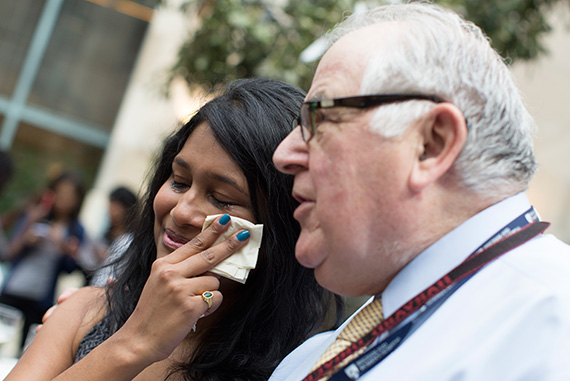
Daniel D. Federman Professor of Medicine and Medical Education at Harvard Medical School Ronald Arky talks with Samyukta Mullangi, who cries tears of joy. She is heading to University of Michigan Hospital. Photo by Rose Lincoln/Harvard Staff Photographer
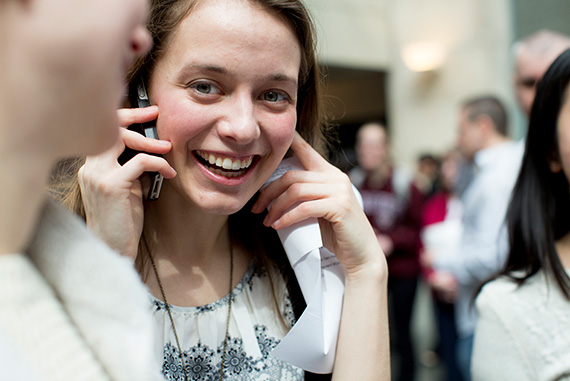
Katherine Schiavoni calls her father to give him the good news that she’s going to Massachusetts General Hospital. Photo by Rose Lincoln/Harvard Staff Photographer
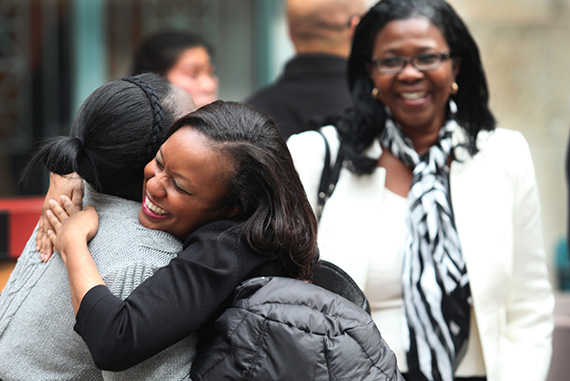
Nicole Jackson (center) celebrates her good news. Photo by Kiera Blessing
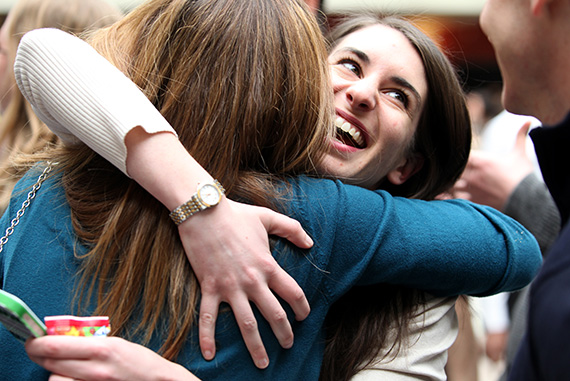
Harvard Medical School students rejoice in learning where they’re headed to complete their residency programs. Photo by Kiera Blessing
Opening doors
Edward Hundert, the Daniel D. Federman, M.D. Professor in Residence of Global Health and Social Medicine and Medical Education and dean for medical education at HMS, noted that the students have worked hard to get to this point, although the road is not likely to get easier.
“The reward for a job well done is another job,” he said.
In addition to hard work, the students will need patience and perseverance moving forward, Hundert said.
He related a quote from Françoise Gilot, the French painter and author who was a muse to Pablo Picasso and the wife of Jonas Salk. “She said that there are two kinds of doors: doors in space and doors in time. Doors in space you have to look for, but doors in time you have to wait for.”
While the students were deeply focused on particular aspects of medicine, they were also interested in more diverse aspects of their careers, and looking forward to finding out which doors would open for them.
Neil Kalwani, a student in the Holmes Society, matched in internal medicine at the Brigham. Kalwani said he may pursue a career in primary care, but is also interested in cardiology and oncology, and in health care reform. In addition to completing his M.D. this year, Kalwani is a candidate for a master’s degree in public policy from the Harvard Kennedy School (HKS).
“I’m going into residency with an open mind, to see what catches my interest as I move along,” he said.
Complex market
The nationwide match, which pairs students and residency programs around the country, is run by the National Resident Matching Program (NRMP), a nonprofit organization founded in 1952 by medical students to provide an orderly and fair way to match applicants to U.S. residency positions.
The mathematical algorithm used to pair the rank-ordered preferences of students and residency program directors was a basis for Alvin Roth’s share of the 2012 Nobel Prize in economics. Roth, the Craig and Susan McCaw Professor of Economics at Stanford University, is also the Gund Professor of Economics and Business Administration Emeritus at Harvard University.
As students looked to the match for signs that will guide their careers through postgraduate training, other observers watched for signs about the future of the U.S. medical workforce.
This year’s match was the largest main residency match in NRMP history. Nearly17,000 U.S. medical school seniors and more than 9,000 other applicants matched to one of the more than 27,000 first-year positions offered in the 2015 match, according to an NRMP statement.
The report said the total number of positions offered this year reached an all-time high, with noteworthy increases in the number of primary care programs and positions offered:
- Internal medicine programs offered 6,770 positions, 246 more than in 2014.
- Family medicine programs offered 3,195 positions, 86 more than in 2014.
- Pediatrics programs offered 2,668 positions, 28 more than in 2014.
Some of the most competitive specialties included dermatology, medicine/psychiatry, obstetrics/gynecology, orthopedic surgery, pediatrics/primary care, physical medicine/rehabilitation, and thoracic surgery. All of the vacancies in those specialties were filled, the NRMP statement said.
General surgery, neurological surgery, otolaryngology, plastic surgery, and radiation oncology had fewer than five unfilled positions after the matching algorithm was processed, according to the NRMP.
How HMS matches up
Out of a total of 161 students in the HMS class of 2015, 157 matched in clinical training programs, and four are pursuing nonclinical positions for next year. Just over 50 percent of matching students will spend some part of their training at an HMS-affiliated program, including 43 percent who will be in HMS-affiliated programs for only their specialty training.
The HMS Office of Student Affairs noted that it no longer attempts to calculate the number of students going into primary care because it is impossible to predict how many people who train in internal medicine will eventually go into primary care, versus specialty care. In addition, the office noted that there is an emerging trend to create merged residencies or other programs that do not allow easy categorization.
This year, 40 students matched in internal medicine (including nine who were designated primary care or global health), 10 matched in pediatrics, five in obstetrics/gynecology, four in family medicine, and two in medicine/pediatrics.




